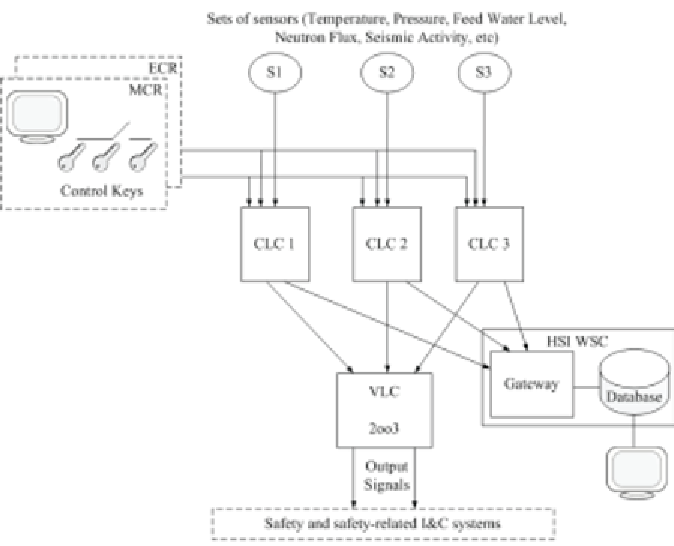Environmental Engineering Reference
In-Depth Information
Island Control Systems, Turbine Island Control
Systems and Automatic Regulation, Control,
Operation and Protection (ARCOP) of Research
Reactor.
Reactor Trip System (RTS):
The RTS continu-
ously monitors the actual values of neutron flux and
other process variables, and it conditions shutdown
signals in case these variables reach their setpoints.
RTS transmits all vital information necessary for
surveillance and monitoring to the control room
and other safety and non-safety systems (e.g.,
initiation status, plant and diagnostic data). RTS
can have 3 or 4 redundant channels depending
on the design basis of the nuclear reactor, and it
can implement a voting logic of two-out-of-three
(2oo3) or two-out-of-four (2oo4). Example of 2oo3
configuration is shown in Figure 5. The external
interfaces of the RTS provide interfaces to power
supplies, process I/Os, communication links, local
inputs, and indicators.
A typical RTS (see Figure 6) has on-line
monitoring and maintenance capabilities. It can
correct its voting logic in case faults are detected,
so that system availability is optimized without
compromising safety. RTS has a self-diagnostic
subsystem, which includes troubleshooting as-
sistance functions for easy localization of faults.
In case of failure, RTS puts itself in the safe state,
signalling actuation for shutdown. RTS also sup-
ports manual actuation of shutdown logic from
the Main Control Room (MCR) or Emergency
Control Room (ECR). The FPGA-based RTS
architecture can be adapted to various reactor
types (e.g., PWR, BWR, PHWR).
There are 28 RTSs produced by RPC Radiy
in operation at Zaporozhe NPP, Rovno NPP,
Khmelnitsky NPP and South-Ukrainian NPP.
Reactor Power Control and Limitation Systems
(RPCLS):
RPCLSs (Figure 7) perform the follow-
ing main functions:
Figure 5. Reactor trip system configuration (2oo3 voting logic version)

Search WWH ::

Custom Search